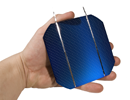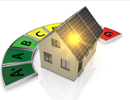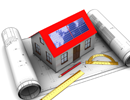Not all solar panels are created equal. With a booming solar market and advances in technology, homeowners are faced with a wide variety of choices from price per watt, to efficiency ratings, to where the solar panels are made. Most likely your solar panels will be made from silicon. Nearly 90 percent of solar cells (the building blocks of a panel) are made from this element. There are three common types of residential solar panels and each boasts unique qualities that address specific challenges.
Quick Quiz: Evaluate Your Solar Situation
1. Is your useable roof space limited?
Yes: If your useable roof space is very limited, you may need the most efficiency to power your home with the fewest panels. High efficiency MONOCRYSTALLINE might be your best choice.
No: If you can fit all the panels you need easily, efficiency per panel is less of a concern and POLYCRYSTALLINE panels are probably a solid economic choice.
2. Are you going solar on a tight budget?
Yes: If panel affordability is important and space is not an issue, POLYCRYSTALLINE is a great, lower-cost option.
No: If cost is not an issue, MONOCRYSTALLINE panels offer added efficiency and many people prefer their dark look aesthetically.
3. Will trees or buildings block some of your array’s sun during the day?
Yes: If shading or a low-angle roof will impact your solar array, THIN FILM panels with their shadow-tolerance may be the right pick for your home to keep efficiency levels maximized.
No: If your entire solar array will get consistent, uniform sun, there’s not a need to opt for thin film, so POLYCRYSTALLINE or MONOCRYSTALLINE panels could be your best bet.
5 Factors When Choosing Solar Panels
In-depth: Monocrystalline, Polycrystalline & Thin Film
The quiz gave you a peek into which solar panels might be best for you, but every roof has multiple variables to consider. This section provides a more detailed look at the three different types of solar panels: monocrystalline, polycrystalline and thin film solar.
According to solar energy expert Shawn O’Meara, the quality of the panel makes a huge difference: “First, look for a manufacturer that has been in the industry for a long time.”
O’Meara prefers monocrystalline, noting that “polycrystalline panels are less expensive, but they’re the budget-minded model and not highly recommended. Thin film technology is constantly evolving and does have some good attributes – it tends to suffer less from temperature co-efficiency – but it’s not that efficient to begin with.”
High quality monocrystalline panels are going to make good power for 20 plus years.
Monocrystalline silicon panels, also known as single-crystalline panels, are characterized by their even coloring and uniform appearance. This high-purity silicon is made of single-crystal wafer cells cut from cylindrical crystal slabs. The deep blue color of the panels is because they are made from a single continuous ingot. They can be trimmed into different forms but are most commonly cut into square-like shapes. They can also be completely circular to minimize waste. While they cost more than other types of silicon, they are also the most efficient, producing more power per square foot than other types.
- Monocrystalline solar panels boast higher efficiency ratings, even in low-light conditions, since they are made from high-purity silicon.
- Higher efficiency ratings mean that monocrystalline solar panels require less space to produce the same amount of power compared to other types of panels.
- Manufacturers put a 25-year warranty on their monocrystalline solar panels, making them the most durable panels.
- This is the most expensive type of silicon. You get what you pay for with these high-quality panels.
- Electricity production of monocrystalline solar panels will decrease significantly if they are subject to shade, dirt or snow. Homeowners will need to consider micro-inverters instead of the commonly used central string inverters.
- The process of creating monocrystalline silicon wafers is wasteful. Cutting fours sides out of a large cylindrical ingot means a significant amount of the original crystal ingot is left unused.
Polycrystalline silicon panels are also known as multi-crystalline panels. The random crystal formations of the silicon give these panels an uneven appearance with various blue colors. As opposed to using one single crystal, these panels are made from a square block of raw silicon that has been melted and poured into a mold. Square wafer cells are cut from blocks of the same shape, minimizing waste. This type of production equals a smaller price tag but also makes it slightly less efficient.
- Production of polycrystalline solar panels is more efficient than monocrystalline panels, resulting in less waste and lower cost.
- Compared to monocrystalline solar panels, polycrystalline solar panels have slightly lower heat tolerance than monocrystalline solar panels, making them less efficient in high temperatures. The difference is minor though and most homeowners do not need to consider this factor.
- Polycrystalline solar panels are less efficient than monocrystalline solar panels since they are not as pure. They typically have 13 to 16 percent efficiency ratings.
- This type of solar panel requires more space than the monocrystalline panels to produce the same amount of electricity.
- Polycrystalline panels are less attractive due to their uneven, speckled blue appearance.
Thin film panels are the least expensive of the three types but also the lowest quality with efficiency ratings between 7 to 13 percent. Because of their poorer performance, they also require more space per watt to produce the same amount of electricity as polycrystalline or monocrystalline silicon panels. Thin film is made by the relatively inexpensive method of depositing photovoltaic materials on a sheet of glass or metal. These materials include cadmium telluride (CdTe) and amorphous silicon (a-Si). The former is the most cost effective thin film technology; the latter creates panels that can be molded into almost any shape. Thin film is a constantly evolving technology and because of the ease of production and the small price tag, it has the potential to make solar accessible for everyone.
- High temperatures and shading impact electricity production less compared to other panel types.
- Production of thin film is easier, making it less expensive to manufacture.
- Thin film can be flexible allowing it to be used in unexpected and innovative ways.
- This type of panel is the most affordable.
- This is not a good option for residential use since thin film requires much more space than other, more efficient panel materials.
- As space needs increase, so too does the cost of the entire solar system, including support structures and wiring.
- The durability of thin film panels is questionable and they often come with a shorter warranty.
PV Technology by the Numbers
Global annual production by monocrystalline, polycrystalline and thin film panels in gigawatt-peak:
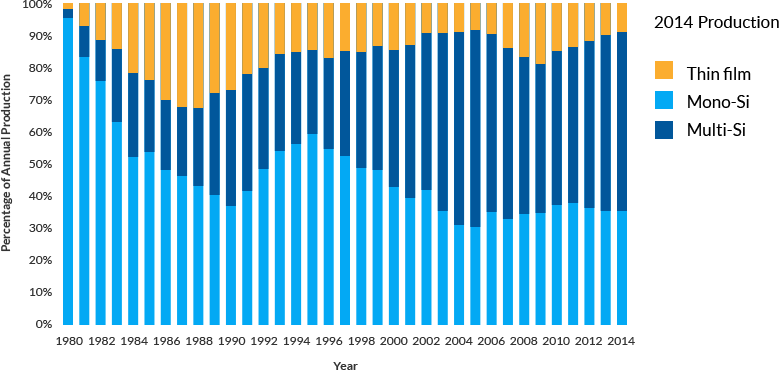
Source: Fraunhofer Institute for Solar Energy Systems, ISE
Considerations for Solar Panel Cost
With solar panels, the first factor on everyone’s minds is cost. Prices vary, ranging from $150 to $350 each. Like with any appliance purchase, the price of the panel is only one factor determining cost effectiveness over time. Consider the following factors:
The physical size of the panel does not mean it will produce more electricity, but it may mean a higher price.
Purchasing power affects what consumers will pay; a homeowner buying eight panels will shell out more than an installation company.
Higher efficiency ratings and longer warranty periods can cost more upfront but will also increase the return on investment over time.
How Solar Panels Are Rated
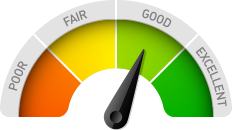
When shopping for solar panels, consumers will see different costs per watt ($/Watt). This measure is used to determine the price of the panel and allows buyers to compare different panels at a glance. However, when comparison shopping, it’s important to keep in mind that a higher dollar per watt does not equal higher efficiency – it may just mean that the panel is simply bigger.
So how does a 255 watt panel compare to a 345 watt panel? The watt refers to a solar panel’s power output. Solar panels are rated in units of watts by the amount of DC (direct current) electricity they produce under standard test conditions. The ratings reflect the panel’s power production when they are in perfect sunlight and temperature settings. Normal output ratings for solar panels today range from 200 to 350 watts. All things considered, installing a solar system with the highest power output you can afford (or that your roof will accommodate) results in the best long-term savings.
However, to determine the best return on investment, it is advisable to consider the power output along with other factors such as the efficiency rating. For example, two solar panels have different power outputs of 200W and 350W. Based on this alone, the consumer will choose the 350W panel but after looking closer it appears both panels have a 20 percent efficiency rating. The latter panel produces more electricity simply because it is significantly larger.
Other factors that impact the actual power output include the location of the home and the placement of the solar system. A system in Seattle facing away from the sun will produce less electricity than a system located in Las Vegas that follows the direction of the sun. Electricity rates and incentives unique to each state also impact how much the homeowner will save over the long run.
However, O’Meara notes, if you plan to lease a solar system, you may not be in control of what type of panel is installed on your home nor how it is installed. In terms of saving money, while leasing a solar system is a popular notion, he encourages homeowners to consider financing options first.
Decoding Solar Panel Specs: 10 Key Terms
All industries have their own jargon, and the solar world is no different. When trying to make a well-informed decision about which solar panels to buy, it’s important to understand the meaning behind its list of specifications. Specs can reveal how heavy the panel is, how much space it requires, how temperature impacts it and more. Read on for the Top 10 specs to understand and why:
Consumers often turn to this spec first as they determine the cost of the solar panel and how much rooftop space it will require. Watts indicate the electrical output of each panel under standard testing conditions. So, a 200-watt panel will ideally generate 200 watt-hours of electricity each hour. Prices will fluctuate relative to how many watts a panel generates, meaning a 100-watt panel will be half the price of a 200-watt panel. The size of the panel is also related to the number of watts, depending on the efficiency of the solar cell. In general, the higher the wattage is, the larger the panel will be.
Measured in inches or millimeters, the dimension reflects a panel’s size. Include rack information and the space required between modules, and you can begin designing the number of rows, row length, and positioning (landscape or portrait) for your roof or ground-mounted solar system. Some manufacturers also diagram the correct rail positioning for their modules. Noting the watts and size of the panel are essential to ensuring that the system is capable of fulfilling your power needs, while also fitting on your rooftop.
Ask the installer how they are attaching the solar system to the roof and who the panel manufacturer is. The quality of the panel and how it’s installed make a huge difference.
One of the most important factors to consider is the durability or longevity of a solar panel. Look for a good performance warranty period of 25 years. This is an indicator of the quality of the panel and the manufacturer’s confidence in its products.
A manufacturer that doesn’t have a strong track record might not be around when you have a problem with your panel.
The weight of the panel can cause issues during the design and permitting process. A basic engineering design for rooftop solar arrays will limit the weight that can be added to a roof structure. Engineering data will consider the total weight of the entire system including the panels and racking, possibly restricting the quantity of panels that can be installed. If for example you’re considering a crystalline, glazed panel with a plastic backsheet, these can weigh about 3 pounds per square foot.
Most panels have a plastic backing material that protects the cells from the elements. According to O’Meara, most homeowners associations require a panel that features a black frame and black backsheet. A white or aluminum backsheet can be seen through the solar cells, making it less attractive.
What the “nameplate” wattage says may not be accurate due to quality control issues. The tolerance rating lets consumers know that the module may generate more (positive rating) or less (negative) than the wattage stated under standard testing conditions.
This rating helps consumers understand how temperature affects the panel’s electricity production. The lower the percentage per degree Celsius/Fahrenheit, the less high heat will impact the panel.
Conversion efficiency lets the buyer know how efficient the panel is at converting light into electrical energy. It also determines how much power the panel will generate. Overall, consumers should look for panels with the highest efficiency rate they can afford.
To encase and protect solar cells, most crystalline panels use low-iron, high-transparency tempered glass with an antireflection surface treatment. This type of glazing is used because of its durability and high clarity. When broken, it shatters into small fragments, rather than dangerous shards. Some panels use plastic for glazing instead of glass to prevent breakage.
For people concerned with the overall environmental impact of using solar, this is a handy spec to note. The embodied energy of the solar panel reflects how much energy it took to make the panel and how much time it will take for the panel to pay for itself in solar generated electricity.

Warranty: What to Look For
There are two main types of warranties to consider before committing to a panel manufacturer or installer. Fully understanding these warranties is critical for having a long-term, low-stress solar energy system for your home.
It’s important to note the difference between production and workmanship warranties.
A 20-25 year production warranty would guarantee that at the end of the term the solar panel will continue at a certain percent of original production.
“The workmanship warranty for the same panel, however, might be 10 years. So, if the frame falls apart at 11 years, the production warranty doesn’t work.”
O’Meara notes that most, but not all, manufacturers differentiate between the production and workmanship warranties. Working with a reputable manufacturer and installer can help consumers avoid warranty issues.
When reviewing a warranty, consumers should know whether the workmanship warranty, also known as a materials or product warranty, is from the panel manufacturer or the system installer.
Some warranties from the manufacturer will not cover labor or shipment so if the panel breaks, you will need to cover labor and shipping expenses to remove the panel, return it to the manufacturer and then reinstall it. With most panels coming from overseas, this can result in a very costly endeavor.
Buyers also need to carefully note any contractual requirement for regular panel maintenance. In some cases lack of care can void the warranty. Maintenance takes time and money. Consumers need to ensure they have the capacity to comply with maintenance requirements.
Typically, the solar cells that are carefully sealed in your solar panel will last longer than any other part of the panel. Power output, or performance, warranties are generally between 25 and 35 years. These warranties will cover solar cell repairs in case the electricity production falls below a certain percentage of the panel’s rated capacity.
Generally, if a defect in the cells results in an array output of less than 80 percent, you would likely be covered. However, if the decrease in production is from any other part of the system, the warranty would not apply. Some production warranties change over the years. For example, at year 15 the panel is guaranteed to perform at 85 percent. By year 20, that number steps down to 80 percent performance efficiency.
9 Tips for Cleaning Your Solar Panels
Solar panels are generally low-maintenance since they have no moving parts. Cleaning panels is an easy and simple process that can often be overlooked. However, it’s important not to underestimate the impact it can have on performance.

Proper maintenance ensures the solar system continues to perform at top capacity and helps prevent damage.
1) First and foremost, be safe. Review your manual before cleaning to learn manufacturer specification on how to clean as well as how to shut down the system if necessary.
2) Gather cleaning materials including a gentle soap, quality soft brush, a squeegee with a long extension, and a hose with a nozzle that can produce a stream of water to reach the panels.
3) It’s important to ensure that while you clean, you stay on the ground. If you can’t reach the roof, consider hiring a professional.
4) Check the weather. If the day is too sunny, the water will evaporate quickly once it touches the hot panels leading to smears and spots. The best time to work is in the morning, especially if there is dew on the panel that can soften the grime.
5) If the panel is dry, dust off any debris.
6) Begin with a hose if there is just a light layer of dust. Be aware that hard mineral-rich water can leave behind deposits on the glass if not dried quickly.

7) If the dust and dirt on the panel requires more elbow grease, fill a bucket with warm water and non-abrasive, gentle soap. Clean with a soft brush or sponge then squeegee dry.
8) If there are oily stains on the panel, spot-clean using isopropyl alcohol.
9) Unless there is visible dust or debris on your panel, Mother Nature often does a good enough job of cleaning tilted, rooftop solar systems.




